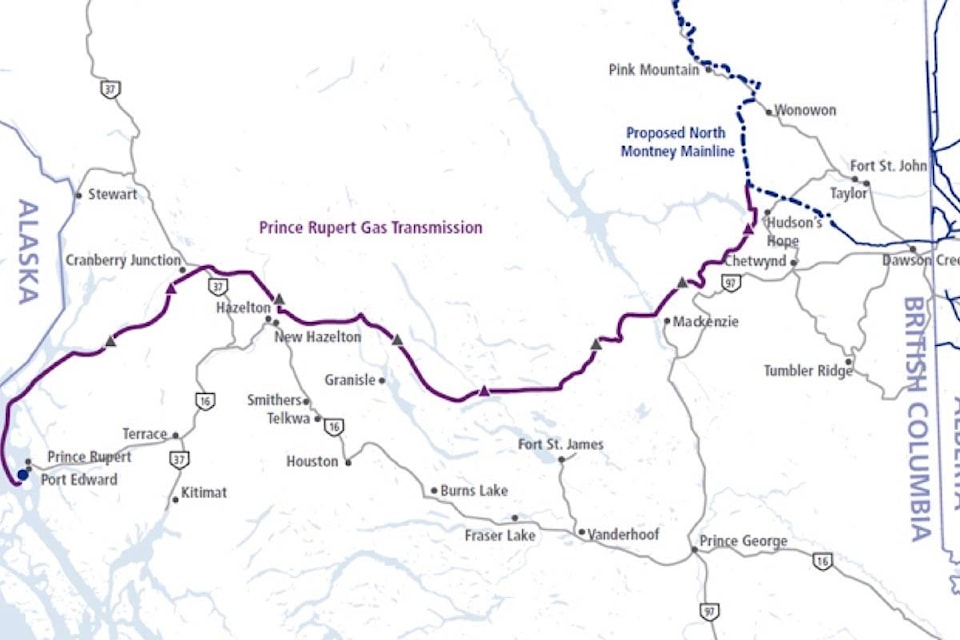TC Energy has announced construction will begin on its recently sold Prince Rupert Gas Transmission Pipeline (PRGT) project in August.
The original project received its environmental permit from B.C.'s regulatory body in 2014 with a plan to carry natural gas from northeast B.C. to a liquefaction facility in Prince Rupert.
The proposed export facility project, majority-owned by the global energy giant Petronas and planned for Lelu Island within the District of Port Edward, was canned in 2017, but TC Energy applied for and received a five-year extension to its pipeline permit in 2019. That permit expires this year unless the project can show the B.C. Environment Assessment Office (EAO) construction has been "substantially started."
In the interim, the Ksi Lisims LNG project has taken shape. The Nisga'a Nation and Calgary-based Western LNG propose a floating liquefaction facility adjacent to Pearse Island north of Gingolx. In March, the partnership purchased the PRGT pipeline project to feed this plant with natural gas from the Northeast.
In a statement issued last week, TC Energy said it expects the sale of the pipeline to close within the month.
"While TC Energy will not have a role in the construction of PRGT, we continue to celebrate Indigenous co-ownership and the development of a major infrastructure project that can deliver lasting benefits to communities," the company statement read.
Rebecca Scott, Ksi Lisims LNG spokesperson confirmed the aggressive timeline to start construction is partially based on the EAO requirement for a substantially started status by Nov. 25 of this year.
The other major factor, she said, is to align with timelines for the liquefaction facility because the pipeline will take much longer to build. Ksi Lisims LNG expects to have permits in place for the plant by the end of the year.
Terms of the deal between TC Energy and the Nisga'a-Western LNG partnership have not been released, but TC Energy said its initial proceeds are not expected to be “material” to the company. If the project is completed, however, TC Energy could see more returns on the back end.
Nevertheless, when the transaction was announced in March, TC Energy president Francois Poirier said “enabling LNG development in B.C. is good for Indigenous communities [and] our customers.”
The roughly 900-kilometre proposed pipeline, beginning in Hudson’s Hope in the Northeast was originally conceived to run across northern B.C. eventually exiting from Nisga’a territory on the coast, then turn south underwater to the proposed Petronas LNG facility near Prince Rupert.
Now, instead of turning south, it would turn north running underwater to the proposed Ksi Lisims LNG floating barge facility.
The company is not overly concerned about permitting for the route change, which requires filing applications to the EAO.
"Amendments are fairly common practices as projects with EA Certificates evolve," Scott said.
While Indigenous co-owned, the project is not without its Indigenous detractors. Both Lax Kw'alaams and Gitanyow, whose lands are also potentially affected, are opposed to the projects as they currently stand wanting new environmental assessments and further consultation.
However, Scott said initial construction activities this summer will not impact other Nations and consultation work is ongoing.
"It is key to understand that the work will be happening on Nisga'a Lands only," she said. "It's also very important to know that the work does not impact ongoing engagement with other Nations about potential improvements and benefits."
Nisga'a Nation president Eva Clayton believes all the concerns will be worked out as the projects progress.
"When we announced that we were buying this project, we knew it represented a historic and meaningful step toward independence and opportunity — not just for the Nisga'a, but for all Indigenous people in Canada," she said. "Our Nation's objective is to build a meaningful economy at home so future generations can live fulfilling lives in the Nass Valley."
